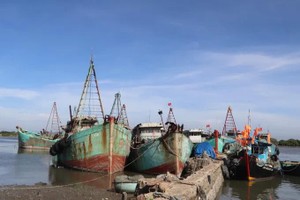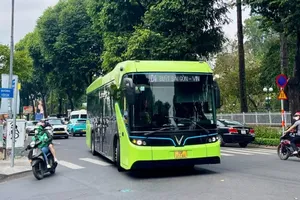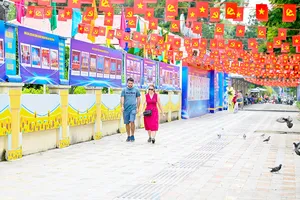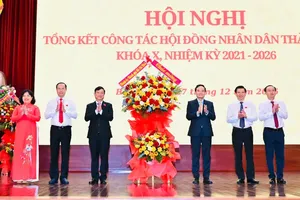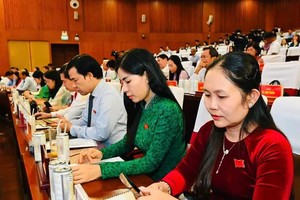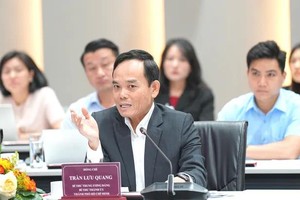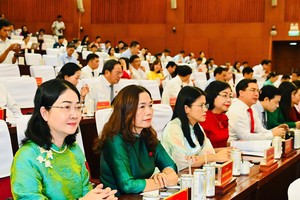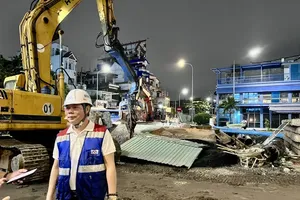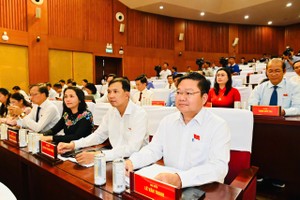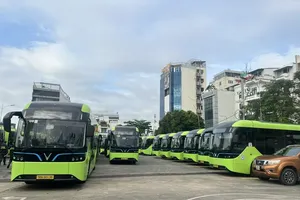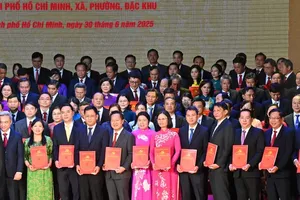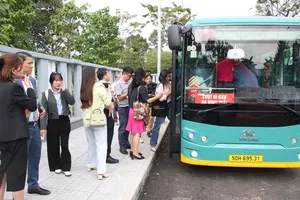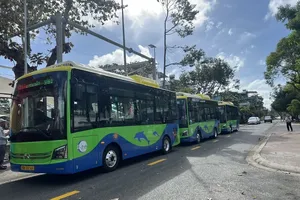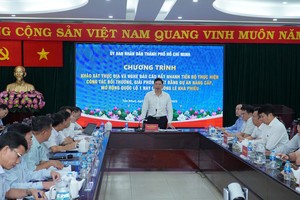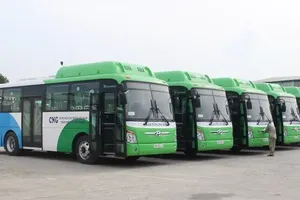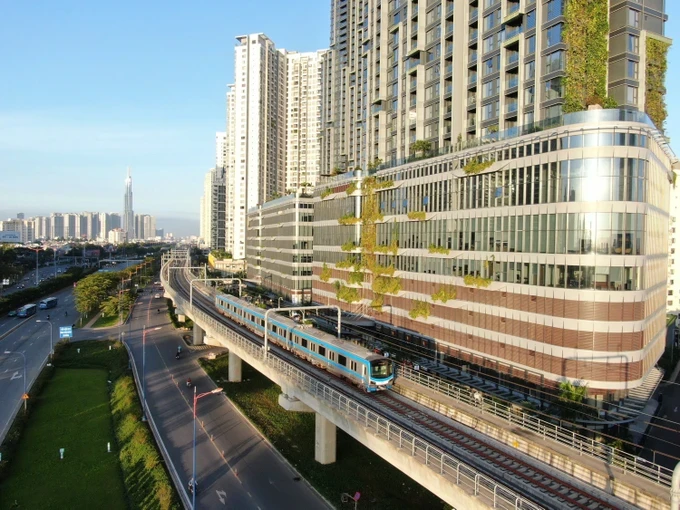
HCMC with its early growth direction shaping
“Surviving was worth it”, chuckled Le Van Quoc when recalling the past with his old comrades. “Only by living do you truly witness the city’s remarkable ascent, seeing how the battlefields we risked everything to defend have transformed into thriving, modern landscapes.”
Their shared sentiment underscores a deep appreciation for HCMC’s persistent progress, a narrative woven into the very fabric of the city’s identity.
This progress is tangible, exemplified by Metro Line No. 1, a key artery in HCMC’s ambitious plan for a 12-line urban railway network extending to 2050 and endorsed by the Prime Minister. The city aims to establish the core of this system by 2030, ultimately creating a comprehensive web of connectivity. Beyond eight radial lines, the blueprint includes two ring lines, a riverside light rail, and another light rail or subway potentially linking to the Can Gio sea tourism zone.
Simultaneously, HCMC is accelerating the development of crucial ring roads. Ring Road 4 promises to underpin infrastructure for the entire Southern Key Economic Zone, while Ring Road 3 will connect the Southeast and Southwest. The completion of Ring Road 2 is set to streamline traffic flow and boost economic dynamism. Looking ahead, the city is preparing major projects like the Can Gio International Transshipment Port and the International Financial Center.
Former Deputy Head Pham Chanh Truc of the Central Economic Commission and former Standing Deputy Secretary of the HCMC Party Committee observed the exceptional level of central government attention bestowed upon the city.
“Rarely does a locality nationwide receive such profound and comprehensive support from the central authorities,” he noted, citing numerous Politburo resolutions specifically addressing the city since 1982, alongside tailored mechanisms and devolved powers granted by the National Assembly and Government.
These include landmark directives like Resolution 01-NQ/TW (September 14, 1982) on HCMC’s duty, Resolution 20-NQ/TW (November 18, 2002) outlining the city’s development to 2010, and Resolution 16-NQ/TW (August 10, 2012) focusing on growth to 2020. Most recently, the Politburo issued Resolution 31-NQ/TW, charting HCMC’s course to 2030 with a vision extending to 2045.
Furthermore, Politburo Resolution 24-NQ/TW (October 7, 2022) on the socio-economic development and security of the Southeast region explicitly positions the city as the region’s nucleus and primary engine of growth.
Dr. Tran Du Lich, member of the National Monetary Policy Advisory Council, pointed out that as early as 2002, Politburo Resolution 20 clearly articulated HCMC’s vital role, not just domestically but also in aspiring to regional prominence among Southeast Asian metropolises. He emphasized the city’s consistent pioneering spirit in embracing central government policies, coupled with its proactive approach to international integration.
This proactive stance likely underpins the National Assembly’s issuance of Resolution 98/2023/QH15 in June 2023. This legislation introduces novel provisions and exceptional mechanisms, designed to provide fresh impetus for the city’s advancement. It addresses practical needs, political and economic imperatives, and the city’s strategic development trajectory.
Subsequently, the Prime Minister established a dedicated Steering Committee to oversee Resolution 98’s implementation, signaling a firm commitment to decentralization and empowerment. The goal is to create optimal conditions for HCMC’s continued upward trajectory, building a civilized, modern, rapidly and sustainably developing city, embodying the spirit of “HCMC for the whole country, the whole country for HCMC”.
Golden legacy - shining future
During his final working visit to HCMC, late General Secretary Nguyen Phu Trong poignantly remarked: “HCMC shines with a golden name. It will strengthen unity and consensus, join forces wholeheartedly, be determined to innovate even more vigorously, strive even harder, and better leverage its leading role and strongest driving force for the Southern Delta region, living up to its titles “steel land – copper citadel”, “pearl of the Far East”, the trust, love, and pride of the entire nation.”
Echoing this sentiment, during his visit to HCMC, General Secretary To Lam reiterated: “The Executive Committee of the HCMC Party Committee and the entire political system need to have an even deeper understanding of the role and position of the city for the whole country and the Southern region, bearing the honor of Uncle Ho’s name – Ho Chi Minh City shines with a golden name.”
Given this unique position, the central government recognizes that implementing HCMC’s planning is not solely the city’s responsibility but a national and regional imperative. At the conference announcing the city’s development plan, Prime Minister Pham Minh Chinh clearly outlined future development objectives.
Accordingly, by 2030, the vision is for HCMC to be a global, civilized, modern, compassionate, dynamic, and creative metropolis. It aims to become a hub for high-quality human resources, modern services and industry, a leader in the green economy, digital economy, and digital society, and the nation’s center for economics, finance, trade-services, culture, education, and science-technology, deeply integrated internationally.
HCMC is projected to hold a prominent position in Southeast Asia, with economic growth rate and per capita gross regional domestic product (GRDP) among the highest in the country, surpassing the high-income threshold, and offering a high quality of life with a rich cultural identity.
Leveraging resolutions that decentralize and empower the city, it has thoroughly decentralized authority to its various agencies, units, and the People’s Committees of districts, towns, and Thu Duc City. This aims to enhance proactivity in implementing sectoral and local tasks, improving administrative effectiveness and efficiency, and ultimately elevating public service quality.
Notably, the recent implementation of Decree 84/2024/ND-CP, piloting further decentralization of state management across eight sectors, has seen the city vigorously devolve power to the grassroots level. Concrete examples include establishing the HCMC Food Safety Department, consolidating state management of food safety across sectors previously under different departments.
In 2025, Vietnam has set a minimum economic growth target of 8 percent. With its established tradition of dynamism and innovation, and its position as the nation’s economic engine, HCMC is determined to achieve double-digit growth, thereby making a significant contribution to the country’s overall economic expansion.
Key highlights of HCMC’s notable achievements:
- HCMC boasts the nation’s largest economic scale, registering a substantial VND1.78 quadrillion (US$69 billion).
- The city’s populace exceeds ten million inhabitants.
- In 2024, HCMC’s average per capita income reached $7,600.
- HCMC is home to the country’s inaugural “city within a city”: Thu Duc City.
- The central government has designated HCMC as one of only two localities to host an International Financial Center.
- The end of 2024 saw HCMC commence operations on its inaugural urban railway line, Metro Line No. 1.
- The city’s budget revenue for 2024 surpassed a formidable VND500 trillion ($19.3 billion).
- Recognized as a creative urban center, HCMC holds membership in UNESCO’s Global Network of Learning Cities.

